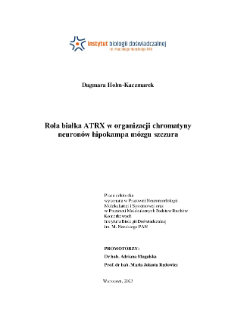- Search in all Repository
- Literature and maps
- Archeology
- Mills database
- Natural sciences
Advanced search
Advanced search
Advanced search
Advanced search
Advanced search

Object
Title: Rola białka ATRX w organizacji chromatyny neuronów hipokampa mózgu szczura : praca doktorska
Institutional creator:
Instytut Biologii Doświadczalnej im. Marcelego Nenckiego PAN
Contributor:
Magalska, Adriana (1976- ) : Supervisor ; Rędowicz, Maria Jolanta (1959– ) : Supervisor
Publisher:
Instytut Biologii Doświadczalnej im. Marcelego Nenckiego PAN
Place of publishing:
Description:
119 pages, 12 pages : illustrations, erratum ; 30 cm ; Bibliography ; Summary in English
Degree name:
Degree discipline :
Degree grantor:
Nencki Institute of Experimental Biology PAS ; degree obtained on 28.06.2024
Type of object:
Abstract:
The ATRX (alpha thalassemia mental retardation syndrome X-linked) protein is an important protein that maintains chromatin structure with helicase properties. Its presence appears to be particularly important in neural tissue, as mutations in the Atrx gene lead to alpha thalassemia mental retardation syndrome X-linked (ATRX) characterized by, among other things, mental retardation. Despite these observations, the function of the ATRX protein in neurons is still poorly understood. Literature data suggest that the main function of this protein is participation in chromatin remodeling and DNA sequence silencing. However, there are also reports indicating its role in the activation of gene expression, demonstrating its important but ambiguous role. My preliminary studies on the occurrence of ATRX protein in hippocampal neurons confirmed its localization in condensed DNA regions. Therefore, the purpose of this dissertation was to determine the localization and role of the ATRX protein in the cell nucleus of neurons in the resting state and after stimulation. I pursued this goal using primary culture of hippocampal neurons subjected to a procedure for chemically inducing long term potentiation (cLTP). Analysis of the ATRX protein localization in the nucleus of neurons showed that in the resting state ATRX localizes at chromatin, colocalizing with chromocenters, while after cLTP evoking it accompanies changes in chromatin organization by surrounding chromatin clusters or colocalizing with them as well as with euchromatin markers, indicating an ambiguous role for ATRX in neurons. In contrast, silencing of Atrx in neurons leads to changes in chromatin organization manifested by increased chromatin condensation, accompanied by changes in the pattern of post-translational modifications of histones. In addition, I identified a new nucleolar structure composed of the ATRX protein, which is required for its maintenance. I also showed that silencing of Atrx results in functional changes in neurons, as reflected by changes in the morphology of dendritic trees, which become smaller and less spread out. In conclusion, my results indicate that ATRX protein plays an important role in neurons in the organization of chromatin and nucleolar structures, and the possible relationship between chromatin structure and cell morphology requires further research.
Detailed Resource Type:
Resource Identifier:
Source:
Language:
Language of abstract:
Rights:
Terms of use:
Copyright-protected material. May be used within the limits of statutory user freedoms
Copyright holder:
Publication made available with the written permission of the author
Digitizing institution:
Nencki Institute of Experimental Biology of the Polish Academy of Sciences
Original in:
Library of the Nencki Institute of Experimental Biology PAS
Access:
Object collections:
- Digital Repository of Scientific Institutes > Partners' collections > Nencki Institute of Experimental Biology PAS
- Digital Repository of Scientific Institutes > Partners' collections > Nencki Institute of Experimental Biology PAS > Dissertations
- Digital Repository of Scientific Institutes > Partners' collections > Nencki Institute of Experimental Biology PAS > Dissertations > PhD Thesis
- Digital Repository of Scientific Institutes > Literature
- Digital Repository of Scientific Institutes > Literature > Thesis
Last modified:
Dec 16, 2024
In our library since:
Jun 24, 2024
Number of object content downloads / hits:
25
All available object's versions:
https://rcin.org.pl./publication/277851
Show description in RDF format:
Show description in RDFa format:
Show description in OAI-PMH format:
| Edition name | Date |
|---|---|
| Holm-Kaczmarek, Dagmara, 2023, Rola białka ATRX w organizacji chromatyny neuronów hipokampa mózgu szczura : praca doktorska | Dec 16, 2024 |
Objects Similar
Grabowska, Agnieszka Kamila
Kraśnicka, Zuzanna Mossakowski, Mirosław Jan (1929–2001) Renkawek, Krystyna
Victorov, Ilia Shaskova, Natalia Kida, Elżbieta Renkawek, Krystyna Mossakowski, Mirosław Jan (1929–2001)
Flatau, Edward (1868–1932)
Gajkowska, Barbara
Łazarewicz, Jerzy
Gadecka, Agnieszka
Mossakowski, Mirosław Jan (1929–2001) Gadamski, Roman (1933–2015)

 INSTYTUT ARCHEOLOGII I ETNOLOGII POLSKIEJ AKADEMII NAUK
INSTYTUT ARCHEOLOGII I ETNOLOGII POLSKIEJ AKADEMII NAUK
 INSTYTUT BADAŃ LITERACKICH POLSKIEJ AKADEMII NAUK
INSTYTUT BADAŃ LITERACKICH POLSKIEJ AKADEMII NAUK
 INSTYTUT BADAWCZY LEŚNICTWA
INSTYTUT BADAWCZY LEŚNICTWA
 INSTYTUT BIOLOGII DOŚWIADCZALNEJ IM. MARCELEGO NENCKIEGO POLSKIEJ AKADEMII NAUK
INSTYTUT BIOLOGII DOŚWIADCZALNEJ IM. MARCELEGO NENCKIEGO POLSKIEJ AKADEMII NAUK
 INSTYTUT BIOLOGII SSAKÓW POLSKIEJ AKADEMII NAUK
INSTYTUT BIOLOGII SSAKÓW POLSKIEJ AKADEMII NAUK
 INSTYTUT CHEMII FIZYCZNEJ PAN
INSTYTUT CHEMII FIZYCZNEJ PAN
 INSTYTUT CHEMII ORGANICZNEJ PAN
INSTYTUT CHEMII ORGANICZNEJ PAN
 INSTYTUT FILOZOFII I SOCJOLOGII PAN
INSTYTUT FILOZOFII I SOCJOLOGII PAN
 INSTYTUT GEOGRAFII I PRZESTRZENNEGO ZAGOSPODAROWANIA PAN
INSTYTUT GEOGRAFII I PRZESTRZENNEGO ZAGOSPODAROWANIA PAN
 INSTYTUT HISTORII im. TADEUSZA MANTEUFFLA POLSKIEJ AKADEMII NAUK
INSTYTUT HISTORII im. TADEUSZA MANTEUFFLA POLSKIEJ AKADEMII NAUK
 INSTYTUT JĘZYKA POLSKIEGO POLSKIEJ AKADEMII NAUK
INSTYTUT JĘZYKA POLSKIEGO POLSKIEJ AKADEMII NAUK
 INSTYTUT MATEMATYCZNY PAN
INSTYTUT MATEMATYCZNY PAN
 INSTYTUT MEDYCYNY DOŚWIADCZALNEJ I KLINICZNEJ IM.MIROSŁAWA MOSSAKOWSKIEGO POLSKIEJ AKADEMII NAUK
INSTYTUT MEDYCYNY DOŚWIADCZALNEJ I KLINICZNEJ IM.MIROSŁAWA MOSSAKOWSKIEGO POLSKIEJ AKADEMII NAUK
 INSTYTUT PODSTAWOWYCH PROBLEMÓW TECHNIKI PAN
INSTYTUT PODSTAWOWYCH PROBLEMÓW TECHNIKI PAN
 INSTYTUT SLAWISTYKI PAN
INSTYTUT SLAWISTYKI PAN
 SIEĆ BADAWCZA ŁUKASIEWICZ - INSTYTUT TECHNOLOGII MATERIAŁÓW ELEKTRONICZNYCH
SIEĆ BADAWCZA ŁUKASIEWICZ - INSTYTUT TECHNOLOGII MATERIAŁÓW ELEKTRONICZNYCH
 MUZEUM I INSTYTUT ZOOLOGII POLSKIEJ AKADEMII NAUK
MUZEUM I INSTYTUT ZOOLOGII POLSKIEJ AKADEMII NAUK
 INSTYTUT BADAŃ SYSTEMOWYCH PAN
INSTYTUT BADAŃ SYSTEMOWYCH PAN
 INSTYTUT BOTANIKI IM. WŁADYSŁAWA SZAFERA POLSKIEJ AKADEMII NAUK
INSTYTUT BOTANIKI IM. WŁADYSŁAWA SZAFERA POLSKIEJ AKADEMII NAUK


































